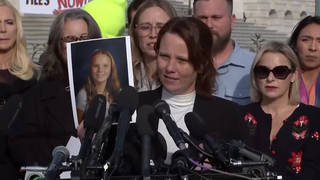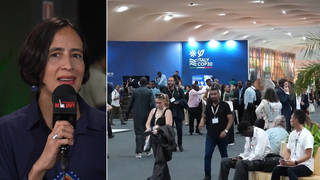
The Federal Communications Commission voted three-to-two on party lines last week to approve a measure that would increase media consolidation. The new rule pushed through by FCC Chairman Kevin Martin lifts a thirty-year old ban on companies seeking to own both a newspaper and television or radio station in the same city. Michael Copps was one of two FCC Commissioners to vote against the rule. [includes rush transcript]
Speech:
Transcript
AMY GOODMAN: The Federal Communications Commission last week voted three-to-two on party lines to approve a measure that would increase media consolidation. The new rule pushed through by FCC Chair Kevin Martin lifts a thirty-year-old ban on companies seeking to own both a newspaper and television or radio station in the same city.
But the reaction against the vote has been swift. Close to 200,000 people have signed an open letter urging Congress to overturn the December 18th vote. Less than twenty-four hours after the vote, Democratic Congressmember Jay Inslee and Republican Congressmember Dave Reichert introduced the Media Ownership Act of 2007, that would overturn the new rules by the FCC.
It was Bush-appointed FCC Chair Kevin Martin, now just forty-one years old, who rammed through the rule changes. He’s served President Bush well. As deputy general counsel for the Bush-Cheney campaign in 2000, he was active during the Florida recount. Before that, he worked for Kenneth Starr at the Office of Independent Counsel during the Monica Lewinsky scandal. Rumor has it he may run for governor of his native North Carolina. His wife, Cathie Martin, was a spokeswoman for Vice President Dick Cheney in the midst of the scandal around the outing of CIA operative Valerie Plame. She now works on Bush’s communications staff.
Today, we’ll play the speech of one of the two dissident FCC commissioners, Michael Copps. Copps has been fighting media consolidation since he was appointed to the FCC in 2001. He is a former history professor. He called the vote a Christmas gift to corporations.
MICHAEL COPPS: I had an opportunity to read a little bit of George Orwell the other day, and it was good preparation for getting ready to deal with this particular item. I think it would do him proud.
We claim to be giving the news industry a shot in the arm, but the real effect is going to be to reduce total newsgathering. We shed big crocodile tears for the financial plight of newspapers, yet the truth is that newspaper profits are about double the S&P 500 average. We pat ourselves on the back for holding six field hearings across the United States, yet today’s decision cites not a single word from the thousands of Americans who waited in long lines for an open mike to testify before us. We say we have closed loopholes, yet we are introducing new ones. We say we’re guided by public comment, yet the majority’s decision is overwhelmingly opposed by the public, as demonstrated in our record and in public opinion surveys. We claim the mantle of scientific research, even as the experts say we’ve asked the wrong questions, used the wrong data, and reached the wrong conclusions.
I am not the only one disturbed by this illogical scenario. Congress and the American people have done everything but march down here to storm to Southwest D.C. and physically shake some sense into us. Everywhere we go, the questions are the same: Why are we rushing to encourage more media merger frenzy, when we haven’t addressed the demonstrated harms caused by previous media merger frenzy? Women and minorities own low single-digit percentages of America’s broadcast outlets, and big consolidated media continues to slam the door in their faces. It’s going to take some major policy changes and a coordinated strategy to fix that. Don’t look for that from this Commission.
Instead, we are told to be content with baby steps to help women and minorities, but the fine print shows that the real beneficiaries will be small businesses owned by white men. So even as it becomes abundantly clear that the real cause of the disenfranchisement of women and minorities is media consolidation, we give the green light to a new round of — yes, you guessed it — media consolidation.
Local news, local music and local groups so often get shunted aside when big media comes to town. Commissioner Adelstein and I have heard the plaintive voices of thousands of citizens all across this land of ours in dozens of town meetings and public forums, from newscasters fired by chain owners with corporate headquarters thousands of miles away to local musicians and artists denied airtime because of big media’s homogenization of our music and our culture, from minorities reeling from the way big media ignores their issues and caricatures them as people to women saying the only way to redress their grievances is to give them a shot to compete for use of the people’s airwaves, from public interest advocates fighting valiantly for a return of localism and diversity to small independent broadcasters who fight an uphill battle to preserve their independence.
It will require tough rules of the road to redress our localism and diversity gaps, too. Do you see any such rules like that being passed today? To the idea that license holders should give the American people high quality programming in return for free use of the public airwaves, the majority answers that we need more study of problems that have been documented and studied to death for a decade and more. Today’s outcome is the same old same old: one more time, we’re running the fast-break for our big media friends and the four corner stall for the public interest.
It’s time for the American people to understand the game that is being played here. Big media doesn’t want to tell the full story, of course, but I have heard first-hand from editorial page editors who have told me they can cover any story, save one — media consolidation — and that they have been instructed to stay away from that one. That’s a story for another day, perhaps.
Today’s story is a decision by the majority unconnected to good policy and not even incidentally concerned with encouraging media to make our democracy stronger. We’re not concerned with gathering valid data, conducting good research or following the facts where they lead us.
Our motivations are less Olympian and our methodology far simpler: We generously ask big media to sit on Santa’s knee, tell us what it wants for Christmas, and then push through whatever of those wishes are politically and practically feasible. No test to see if anyone’s been naughty or nice. Just another big shiny present for the favored few who already own an FCC license — and a lump of coal for the rest of us. Happy holidays!
If you need convincing of just how non-expertly this expert agency has been acting lately, you could not have a better example than the formulation of the cross-ownership rule that the majority will adopt today. I know it’s a little detailed to see how the sausage is made, but it’s worth a look.
On November 2, 2007, with just a week’s notice, the FCC announced that it would hold its final media ownership hearing in Seattle. Despite the minimal warning, 1,100 citizens turned out to give intelligent and impassioned testimony on how they believed the agency should write its media ownership rules. Little did they know that the fix was already in, and that the now infamous New York Times op-ed was in the works announcing a highly detailed cross-ownership proposal.
Put bluntly, those Commissioners and staff who flew out to Seattle, sixteen witnesses, the Governor, the State Attorney General and all the other public officials who came, plus the 1,100 Seattle residents who had chosen to spend their Friday night waiting in line to testify were, as Representative Jay Inslee put it, treated like “chumps.” Their comments were not going to be part of the agency’s formulation of a draft rule; it was just for show, to claim that the public had been given a chance to participate. The agency has treated the public like children allowed to visit the cockpit in an airliner — you know, when you go up there with your little kid, and you’re not actually allowed to fly the plane, but they’re permitted for a brief, false moment to imagine that they are.
The New York Times op-ed appeared on November 13, the next business day after the Seattle meeting. That same day, a unilateral public notice was issued, providing just twenty-eight days for people to comment on the specific proposal, with no opportunity for replies. The agency received over 300 comments from scholars, concerned citizens, public interest advocates, and industry associations, the overwhelming majority of which condemned the plan. But little did these commenters know that on November 28, two weeks before their comments were even due, the draft order on newspaper-broadcast cross ownership had already been circulated. Once again, public commenters were treated as unwitting and unwilling participants in a Kabuki theater.
Then, last night at 9:44 p.m., just a little more than twelve hours before the vote was scheduled to be held and long after the sunshine period had begun, a significantly revised version of the order was circulated. Among other changes, the item now granted all sorts of permanent new waivers and provided a significantly altered new justification for the twenty-market limit. But the revised draft mysteriously deleted the existing discussion of the “four factors” to be considered by the FCC this morning in examining whether a proposed combination was in the public interest. And in its place, the new draft simply contained the cryptic words “[Revised discussion to come].” That’s what we got last night at 9:44. And although my colleagues and I were not apprised of the revisions, USA Today fared better, because it apparently got an interview that enabled it to present the Chairman’s latest thinking. Maybe we really are the Federal Newspaper Commission.
Finally, at 1:57 this morning, we received a new version of the proposed test for allowing more newspaper-broadcast combinations. I cannot claim that I fully appreciate the test’s finer points, given the lateness of the hour and the fact that there was no time afforded to parse the finer points of the new rule. But this much is clear: the new version keeps the old loopholes and includes two new ones. Finally, finally, as I walked out of the office at 11:15 this morning, we received a revised paragraph on the details of the “four factors.” And forgive me if I am unable to speak expertly about what they mean to the substance of this decision.
This is not the way to do rational, fact-based, and public interest-minded policymaking. It’s actually a great illustration of why administrative agencies are required to operate under the constraints of administrative process, and the problems that occur when they ignore that duty. At the end of the day, process matters. Public comment matters. Taking the time to do things right matters. A rule reached through a slipshod process and capped by a mad rush to the finish line will, purely on the merits, simply not pass the red face test. Not with Congress. Not with the courts. Not with the American people.
It’s worth stepping back for a moment from all the detail here to look at the fundamental rationale behind today’s terrible decision. Newspapers need all the help they can get, we are told. A merger with a broadcast station in the same city will give them access to a revenue stream that will let them better fulfill their newsgathering mission. At the same time, we’re also assured, our rules will require “independent news judgment” (at least among consolidators outside the top twenty markets). In other words, we can have our cake and eat it, too: the economic benefits of consolidation without the reduction of voices that one would ordinarily expect when two news entities combine.
But how on earth can this be? To begin with, to the extent that the two merged entities are truly “independent,” then there won’t be the cost savings that were supposed to justify the merger in the first place. On the other hand, if independence merely means maintaining two organizational charts for the same newsroom, then we won’t have any more reporters on the ground keeping an eye on government. Either way, we can’t have our cake and eat it, too.
AMY GOODMAN: Federal Communications Commissioner Michael Copps speaking just before the vote to ax the ban on newspaper-broadcast cross-ownership. We’ll come back to his speech in a minute.
[break]
AMY GOODMAN: We return to the speech of the dissident Federal Communications Commissioner Michael Copps, speaking on December 18th, right before the vote to ax the ownership rules, the ownership ban between newspaper and a radio/television in a town, took place. Copps said the FCC’s decision to ease the restrictions on media consolidation would negatively impact both minority and female ownership and also undermines serious coverage of local politics.
MICHAEL COPPS: In the final analysis, the real winners today are businesses that are in many cases quite healthy, and the real losers are going to be all of us who depend on the news media to learn what’s happening in our communities and keeping an eye on local government. Despite all the talk you may hear today about the threat to newspapers from the internet and new technologies, today’s order actually deals with something quite old-fashioned. Powerful companies are using political muscle to sneak through rule changes that let them profit at the expense of the public interest. They are seeking to improve their economic prospects by capturing a larger percentage of the news business in communities across the United States.
Let’s get beyond the weeds of corporate jockeying and inking up our rubber stamps for a new round of media consolidation to look for a moment at what we’re not doing today. That’s the real story, I think, that the important issues of minority and female ownership and broadcast localism and how they are being short-changed by today’s rush to judgment.
First, on minority and female ownership, racial and ethnic minorities make up 33% of America’s population. They own a scant 3% of all full-power commercial television stations. And that number is plummeting. Free Press recently released a study showing that during just the past year the number of minority-owned full-power commercial TV stations declined by eight-and-a-half percent, and the number of African American-owned stations — get this — decreased by nearly 60%. It’s almost inconceivable that this shameful state of affairs could be getting worse, yet here we are.
In most places there is something approaching unanimity that this has to change. Broadcasters, citizens and members of Congress, and every leading civil rights organization agree that the status quo is not acceptable. Each of my colleagues has recognized, I think, that paltry levels of minority and female ownership are a reality, which makes today’s decision all the more disappointing. There was a real opportunity here to do something meaningful today after years of neglect, and we blew it.
It didn’t have to be this way. I proposed both a process and a solution. We should have started by getting an accurate account of minority and female ownership. That’s the one that the Congressional Research Service and the Government Accountability Office both just found that we do not have at the FCC. The fact that we don’t even know how many minority and female owners there are is indicative of how low this issue is on the FCC’s list of priorities. We also should have convened an independent panel, like proposed by Commissioner Adelstein, and endorsed by many, that would have reviewed all of the proposals before us, prioritized them and made recommendations for implementation. We could have completed this process in ninety days or less and then would have been ready to act.
Today’s item ignores the pleas of the minority community to adopt a definition of “Eligible Entity” that could actually help their plight. Instead, the majority directs their policies at general “small businesses,” a decision that groups like Rainbow/PUSH and the National Association of Black Owned Broadcasters assert will do little or nothing for minority owners. Similarly, MMTC and the Diversity and Competition Supporters conclude that they would rather have no package at all than one that includes this definition. Lack of a viable definition poisons the headwaters. So should we wonder why the fish are dying downstream?
So while I can certainly support the few positive changes in this item that do not depend on the definitional issue, such as the adoption of a clear non-discrimination rule, these are overshadowed by the truly wasted opportunity to give potential minority and female owners a seat at the table they have been waiting for and have deserved for so very long. My fear now is that with cross-ownership done, the attentions of this Commission will turn elsewhere.
On localism, at the same time that we have shamefully ignored the need to encourage media ownership by women and minorities, we have witnessed a dramatic deterioration of the public interest performance of many of our licensees. We have witnessed the number of statehouse and city hall reporters declining decade after decade, despite an explosion in state and local lobbying. The number of channels have indeed multiplied, but there is far less local programming and reporting being produced.
Are you interested in hearing about local politics from the evening news? About 8% of such broadcasts contain any local political coverage at all, including races for the House of Representatives, and that was during the thirty days before the last presidential election. Interested in how TV reinforces stereotypes? Consider that the local news is four times more likely to show a mug shot during a crime story if the suspect is black rather than white.
The loss of localism impacts our music and entertainment, too. Just this morning, I had an email from a musician who took a trip of several hundred miles and heard the same songs played on the car radio everywhere he traveled. Local artists, independent creative artists and small businesses are paying a frightful price in lost opportunity. Big consolidated media dampens local and regional creativity, and that begins, my friends, to mess around pretty seriously with the genius that is America.
It’s a travesty. We allow the nation’s broadcasters to use half a trillion dollars of the people’s spectrum — for free. In return, we require that they serve the public interest: devoting at least some airtime for worthy programs that inform viewers, support local arts and culture, and educate our children — in other words, that aspire to something beyond just minimizing costs and maximizing revenue.
Once upon a time, the FCC actually enforced this bargain by requiring a thorough review of a licensee’s performance every three years before renewing the license. But during decades of market absolutism, we pared that down to “postcard renewal,” a rubber stamp every eight years with no substantive review.
So, to begin with, the FCC needs to reinvigorate the license-renewal process. We need to look at a station’s record every three or four years. I’m disappointed that the majority has so cavalierly dismissed this idea. And we should be actually looking at the record. Did the station show original programs on local civic affairs? Did it broadcast political meetings? In an era where too many owners live thousands of miles away from the communities that they allegedly serve, do these owners meet regularly with local leaders and the public to receive feedback? Why don’t we make sure that’s done before we vote to allow more media consolidation?
In 2004, the Commission opened up a notice of inquiry to consider ways to improve localism by better enforcing the quid pro quo between the nation’s broadcasters and the public. The notice addressed many of the questions raised by earlier dormant proceedings dating from years before. Today’s localism notice asks more questions and tees up some very meritorious ideas, but again my question: why the rush to vote more consolidation now, consolidation that has been the bane of localism, and why put off systematic actions to redress the harms consolidation has inflicted?
Our FCC cart is ahead of our horse. Before allowing Big Media to get even bigger — and to start the predictable cycle of layoffs and downsizing that is the inevitable result of, indeed the economic rationale for, many types of mergers — we should be enforcing clear obligations for each and every FCC licensee.
Those who look for substantive action on these important issues concerning localism and minorities will look in vain. Once the majority works its way on cross-ownership, I’m not optimistic about prospects for future action on these fronts. We’re told that we cannot deal with localism and minority ownership because that would require delay. But these questions have been before the Commission for a decade, and they have been ignored year after year. These issues could have been — should have been — teed up ten years ago. We begged for that in 2003, when we sailed off on the calamitous rules proposed by Chairman Powell and pushed through in another mad rush to judgment. Don’t tell me it can’t be done. It should have been done years ago. And we had the chance again this time around. Now, because of a situation not of Commissioner Adelstein’s or my making, we are accused of delaying just because we want to make things better before the majority makes them worse.
When I think about where the FCC has been and where it is today, two final conclusions:
First, the consolidation we have seen so far and the decision to treat broadcasting as just another business has not produced a media system that does a better job of serving most Americans. Quite the opposite is true. Rather than reviving the news business, it has led to less localism, less diversity of opinion, less serious political coverage, fewer jobs for journalists, and the list goes on.
Second, I think we have learned that the purest form of commercialism and high-quality news make very uneasy bedfellows. As my own hero, Franklin Delano Roosevelt, put it in a letter to Joseph Pulitzer, “I have always been firmly persuaded that our newspapers cannot be edited in the interests of the general public from the counting room.” And I think that applies to broadcast journalism, too. This is not to say that good journalism is incompatible with making a profit. I believe that both interests can be balanced. I believe both interests must be balanced. But when TV and radio stations are no longer required by law to serve their local communities and are owned by huge national corporations dedicated to cutting costs through economies of scale, it should come as no surprise that, in essence, viewers and listeners have become the products that broadcasters sell to advertisers. And that’s you and me I’m talking about.
We could have been — should have been — here today lauding the best efforts of government to reverse these trends and to promote a media environment that actually strengthens American democracy rather than weakens it. Instead, we are marking not just a lost opportunity but the allowance of new rules that head media democracy in exactly the wrong direction.
I take great comfort from the conclusion of another critic of the current media system, Walter Cronkite, who said, “America is a powerful and prosperous nation. We certainly should insist upon, and can afford to sustain, a media system of which we can be proud.”
So now it’s up to the rest of us. The situation isn’t going to repair itself. Big media is not going to repair it. This Commission is apparently not going to repair it. But the people and their elected representatives and attentive courts can repair it. Last time the Commission went down this road, the majority heard and felt the outrage of millions of citizens and Congress and then the court. Today’s decision is just as dismissive of good process as that earlier one, just as unconcerned with what people have said, just as heedless of the advice of our oversight committees and many other members of Congress, and just as stubborn — perhaps more stubborn — because this time it knows, or should know, what’s coming. Last time a lot of insiders were surprised by the country’s reaction. This time they should be forewarned. I hope, I really hope, that today’s majority decision will be consigned to the fate it deserves and that one day in the not-too-distant future we can look back upon it as an aberration from which we eventually recovered. We have had a dangerous, decades-long flirtation with media consolidation. I would welcome a little romance with the public interest for a change. Thank you.
AMY GOODMAN: Michael Copps, dissident Federal Communications Commissioner, speaking just before the vote to ax the ban on newspaper-broadcast cross-ownership that took place on December 18.












Media Options